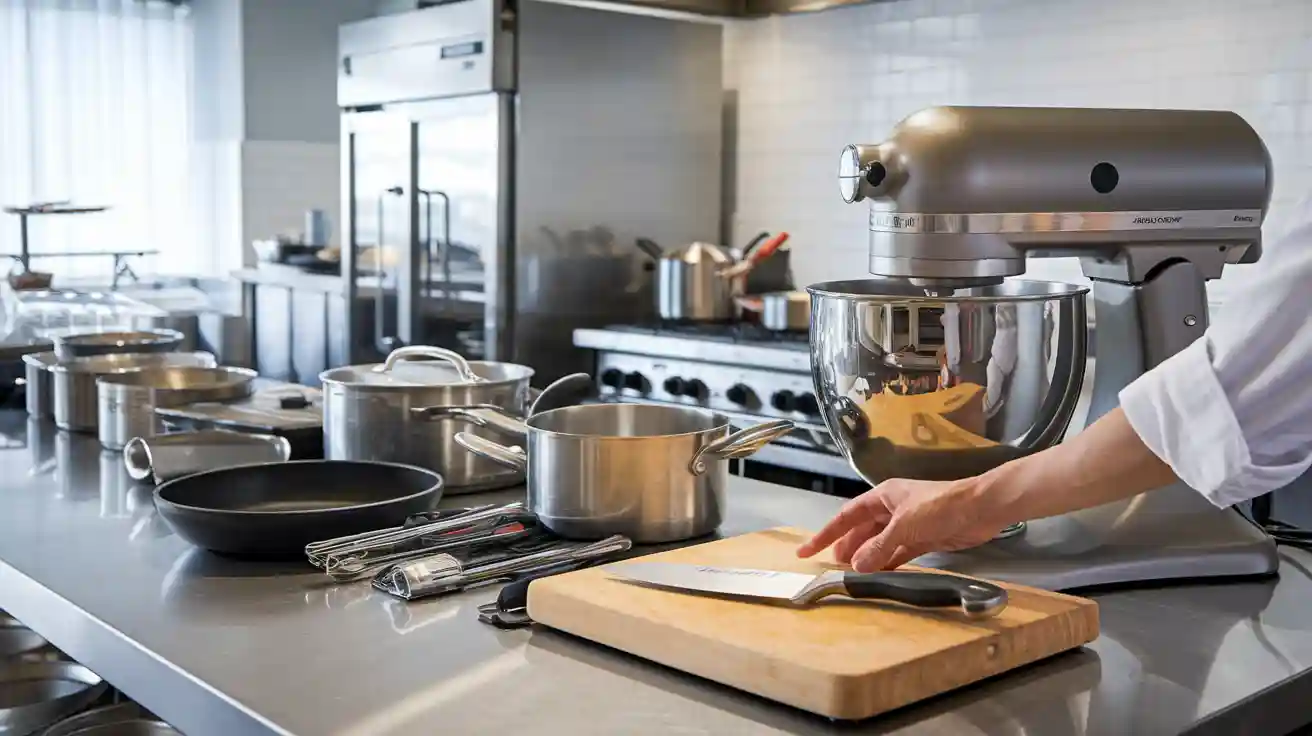
If you want your restaurant to run smoothly, you need a solid cooking equipment list. Picking the right commercial restaurant equipment keeps your kitchen safe and efficient. A well-chosen kitchen equipment list helps you avoid common issues like poor equipment maintenance or unsafe layouts.
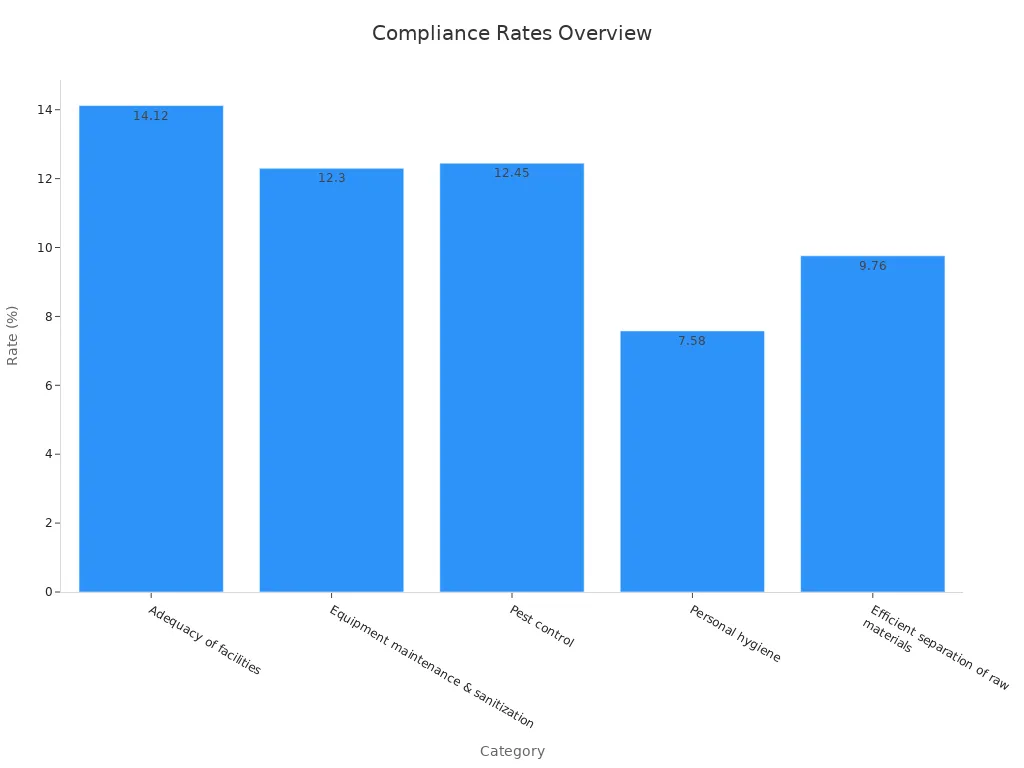
You set your commercial kitchen up for success with essential commercial restaurant equipment. Energy-efficient commercial kitchen equipment also cuts down on costs. The importance of equipment for commercial kitchens goes beyond tools—it shapes your restaurant’s safety and future. Every restaurant kitchen equipment choice matters. Good restaurant kitchen equipment supports compliance and keeps your commercial kitchen safe. That’s why a thoughtful cooking equipment list is key for new restaurants. The right restaurant kitchen equipment brings the importance of equipment for commercial kitchens into focus and helps your business thrive.
Cooking Equipment List for New Restaurants
When you open a restaurant, your kitchen equipment list becomes your best friend. The right commercial restaurant equipment helps you cook faster, safer, and more efficiently. Let’s break down the essential restaurant kitchen equipment you need to get started.
Ranges and Ovens
You can’t run a commercial kitchen without a solid range and oven. These workhorses handle everything from boiling pasta to baking bread. Gas ranges heat up quickly and give you great control over the flame. Electric ranges offer steady, even heat. Convection ovens use fans to circulate hot air, so your food cooks evenly and faster. Combination ovens (combi ovens) let you steam, bake, and roast in one unit. When you build your cooking equipment list, always include a reliable range and oven. They form the backbone of your restaurant kitchen equipment.
Grills and Griddles
Grills and griddles bring versatility to your commercial kitchen. You can sear steaks, toast sandwiches, or cook pancakes all on the same surface. Many new restaurants choose grills with dual-sided grilling technology, like the Garland XPress Grill, because it cuts cooking times and spreads heat evenly. Some models use infrared burners, such as the Vulcan VTEC series, which give you precise temperature control and can lower energy use by up to 35%. Smart grills let you monitor and program settings remotely, making your kitchen equipment list even more efficient.
Tip: Customers love freshly grilled foods. Multi-functional grills, like the Ninja AG301 Foodi 5-in-1, help you meet that demand while saving space.
Here’s what makes modern grills and griddles stand out:
- Dual-sided grilling cooks food faster and more evenly.
- Infrared burners save energy and keep temperatures steady.
- Smart features let you control cooking from your phone or tablet.
- Healthier cooking with less fat and even heat.
- Energy-efficient models can cut costs by up to 50%.
- Portable options work well for outdoor dining or food trucks.
Restaurant kitchen equipment like this keeps your menu flexible and your customers happy.
Deep Fryers
Deep fryers are a must for crispy fries, chicken, and more. You’ll find both electric and gas models in commercial restaurant equipment. Each type has its strengths. Electric fryers recover temperature quickly between batches, while gas fryers heat up faster and reach higher temperatures. Your choice depends on your menu and kitchen setup.
Here’s a quick comparison:
| Feature | Electric Fryers | Gas Fryers |
|---|---|---|
| Power/Heat Source | 1,600W to 24,000W | 26,500 to 170,000 BTU |
| Heat-up Time | 15-20 minutes | 5-10 minutes |
| Temperature Recovery | Excellent | Good |
| Temperature Range | Up to 375°F | Up to 400°F |
| Operating Cost | Higher if electricity is expensive | Lower where gas is affordable |
| Installation | Plug-and-play, portable | Needs permanent gas line |
| Output Capacity | 15-60 lbs/hr (countertop), 40-100+ lbs oil (floor) | 60-200 lbs/hr (floor), 50-100 lbs oil (tube-type) |
| Recovery Speed | Superior between batches | Faster initial heat-up |
Many floor models include built-in filtration systems, which can cut oil costs by up to 40%. When you add a fryer to your kitchen equipment list, think about your menu volume and energy costs. The right fryer keeps your restaurant kitchen equipment running smoothly during busy hours.
Broilers and Salamanders
Broilers and salamanders help you finish dishes with a perfect crust or melt cheese just right. You can use them to caramelize sugar on desserts or give steaks a final sear. Salamanders mount above your range, saving space in your commercial kitchen. Broilers deliver intense heat from above, making them ideal for quick finishing touches. When you plan your restaurant cooking equipment, don’t skip these tools. They add flavor and visual appeal to your plates.
Steamers and Kettles
Steamers and kettles make bulk cooking fast and easy. Steamers cook vegetables, seafood, and dumplings without drying them out. They save time and deliver consistent results. Steam jacketed kettles heat food from all sides, so soups and sauces cook evenly and don’t burn. These kettles use about 35% less energy than regular stock pots. You can tilt some models to pour out food safely, which helps prevent injuries.
- Steam jacketed kettles cook faster with even heat.
- You get precise temperature control, so you don’t have to watch the pot all the time.
- Energy savings add up, lowering your commercial kitchen’s utility bills.
- Tilting kettles make pouring and cleaning safer and easier.
- Food doesn’t stick or burn, so cleanup takes less time.
Note: Steamers work best with filtered water. Hard water can damage them and raise maintenance costs, so always check your water quality.
When you build your kitchen equipment list, steamers and kettles help you serve large groups quickly and keep your food quality high.
Commercial Kitchen Equipment for Refrigeration
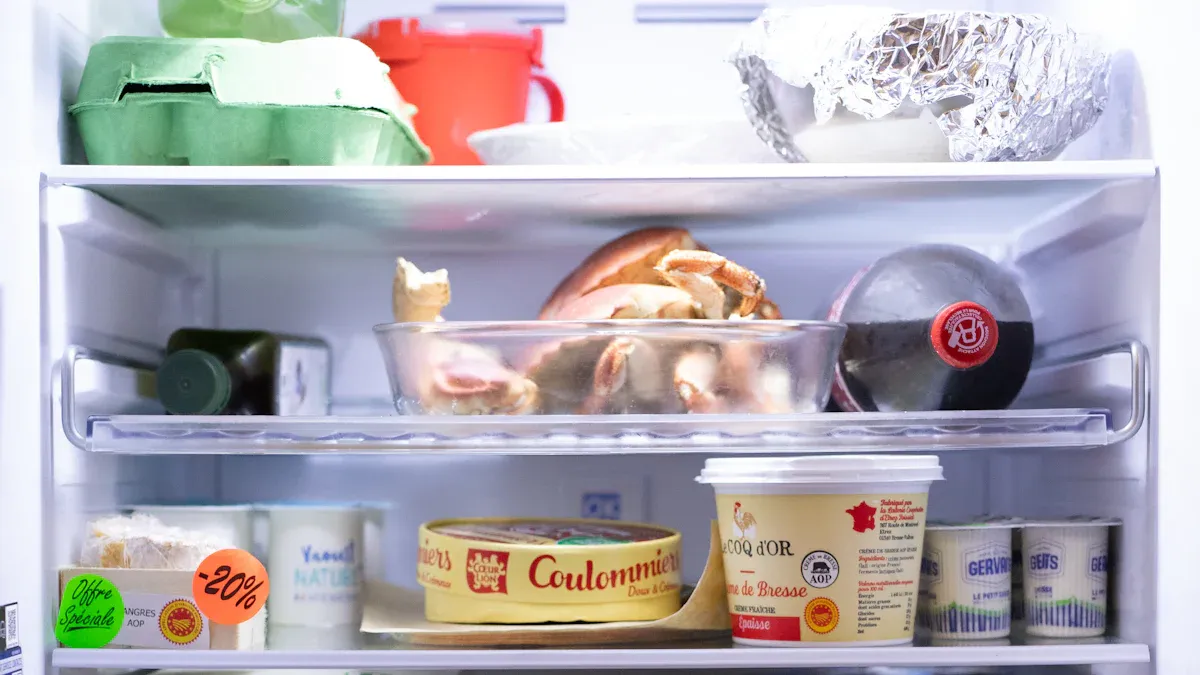
Reach-In Refrigerators
You need a reliable reach-in refrigerator to keep your ingredients fresh and safe. These units fit right into your kitchen layout and let you grab what you need fast. Most commercial restaurant equipment brands design reach-ins with strong shelves and easy-to-clean interiors. You can choose single, double, or triple-door models based on your space and menu.
Freezers
Commercial freezers work harder than residential ones. They handle heavy use, frequent door openings, and big inventory loads without letting the temperature drop. This keeps your food safe and prevents spoilage. You should always pick a commercial freezer over a home model. They last longer, keep food at steady temperatures, and help you avoid costly breakdowns. Professional installation and regular maintenance boost their reliability even more.
Prep Tables and Undercounter Units
Prep tables and undercounter units make your kitchen workflow smoother. They give you extra workspace and keep ingredients within reach. Studies show that using refrigerated prep tables can increase usable workspace by 30% and cut prep time by 20%. You also see fewer health code violations and a quick return on investment.
| Efficiency Metric | Improvement/Result | Description/Context |
|---|---|---|
| Workspace increase | 30% more | NYC bistro after switching to refrigerated prep tables |
| Prep time reduction | 20% faster | Time-motion studies with integrated prep tables |
| Health code violations | 45% fewer | Restaurants using refrigerated prep tables |
| ROI payback period | 14 months | Labor savings on commercial-grade units |
Walk-In Coolers
Walk-in coolers give you lots of space for bulk storage. They keep temperatures steady, even when you open the door often. This helps stop bacteria from growing and keeps your food safe. Features like digital thermostats and alarms help you stay on top of food safety rules. Walk-ins also make it easy to organize your inventory and cut down on waste.
Ice Machines
Ice machines are a must for drinks, food prep equipment, and even some desserts. Modern commercial ice machines save energy and keep things clean. About 35% of buyers pick energy-efficient models, which can lower utility bills by up to 25%. Many restaurants now use machines with antimicrobial linings and touch-free dispensers for better hygiene.
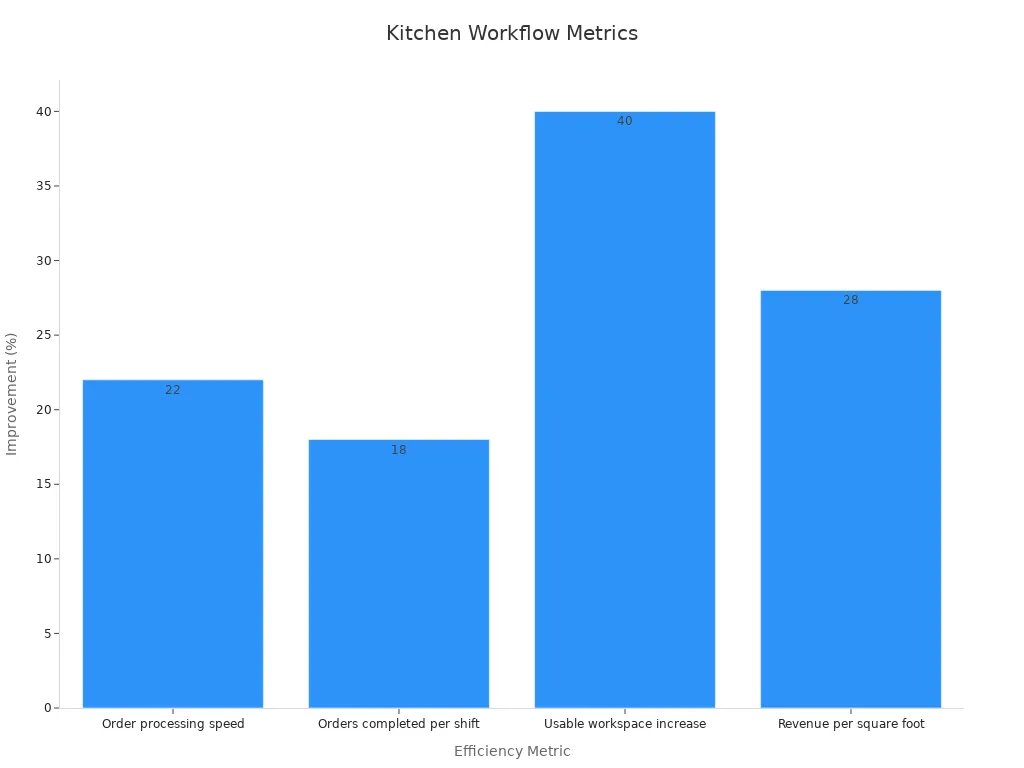
Food Preparation Equipment for Restaurants
Food Processors
You need food processors to speed up chopping, slicing, and mixing. These machines save you time and help you keep food sizes consistent. Most restaurants pick models with stainless steel parts because they last longer and are easy to clean. Stainless steel also resists rust, which keeps your food safe. When you choose food prep equipment, look for processors that handle different tasks. Some models let you switch blades for slicing, grating, or pureeing. This flexibility helps you prepare many menu items with one tool.
Mixers
Mixers are a must if you bake bread, make dough, or whip up sauces. You can find stand mixers and floor mixers for different kitchen sizes. Many chefs prefer mixers with automatic settings. These make your job easier and keep results the same every time. Newer mixers use energy-saving motors and strong parts, so they last longer and use less power. You want commercial kitchen equipment that stands up to daily use and keeps your kitchen running smoothly.
Slicers
Slicers help you cut meats, cheeses, and veggies quickly. You get even slices, which makes your food look better and cook evenly. Choose slicers with smooth, easy-to-clean surfaces. Stainless steel blades work best because they stay sharp and resist stains. Always follow cleaning steps to avoid cross-contamination. Good slicers make your food prep equipment safer and more efficient.
Blenders
Blenders are perfect for smoothies, sauces, and soups. You want a blender that can handle tough jobs without breaking down. Many restaurants pick blenders with strong motors and automatic features. These models save time and reduce mistakes. Look for blenders made from durable materials. This helps you avoid costly repairs and keeps your commercial kitchen tools and equipment in top shape.
Cutting Boards and Prep Counters
Cutting boards and prep counters give you a safe place to work. Use color-coded boards to prevent mixing raw meats with veggies. Most kitchens use boards made from plastic or wood, but stainless steel counters are best for easy cleaning. Smooth surfaces help you clean up fast and lower the risk of germs. Always keep your prep area tidy. This keeps your food safe and your kitchen efficient.
Tip: Set up clear cleaning routines for all food prep equipment. This helps you meet health codes and keeps your kitchen safe for everyone.
Storage Solutions in Commercial Restaurant Equipment
Keeping your kitchen organized starts with smart storage. The right commercial storage solutions help you work faster, stay safe, and keep food fresh. Let’s look at the essentials you need for your commercial restaurant equipment list.
Shelving Units
Shelving units give you a place for everything. Stainless steel shelves last a long time and resist rust, so you save money on replacements. You can stack shelves high to use every inch of space. Modular shelving lets you change your setup as your restaurant grows. When you set up storage zones for dry goods, cold items, and equipment, your staff finds what they need quickly. Clear labels and color-coding make it even easier to stay organized.
Tip: Regular cleaning keeps your shelving units in top shape and helps you pass health inspections.
Dry Storage Bins
Dry storage bins keep flour, sugar, and grains safe from pests and moisture. Stackable bins help you use vertical space, which is important in a busy commercial kitchen. Many bins fit under shelves or in tight spots, so you don’t waste any room. Labeled bins help you track inventory and cut down on waste.
Ingredient Bins
Ingredient bins make bulk storage simple. You can roll them under prep tables for easy access. Their shape fits neatly into shelving nooks, saving floor space. Some bins stack, so you can build a storage system that works for your kitchen. Easy access means your team spends less time searching for ingredients and more time cooking.
Extra Storage Containers
Extra storage containers come in all sizes. Use them for leftovers, sauces, or prepped veggies. Choose containers with tight lids to keep food fresh and safe. Clear containers let you see what’s inside, so you avoid waste and keep your commercial kitchen running smoothly.
Organized storage supports food safety and helps you control costs. Smart storage choices in your commercial restaurant equipment list pay off every day.
Dishwashing and Cleaning Equipment for New Restaurants
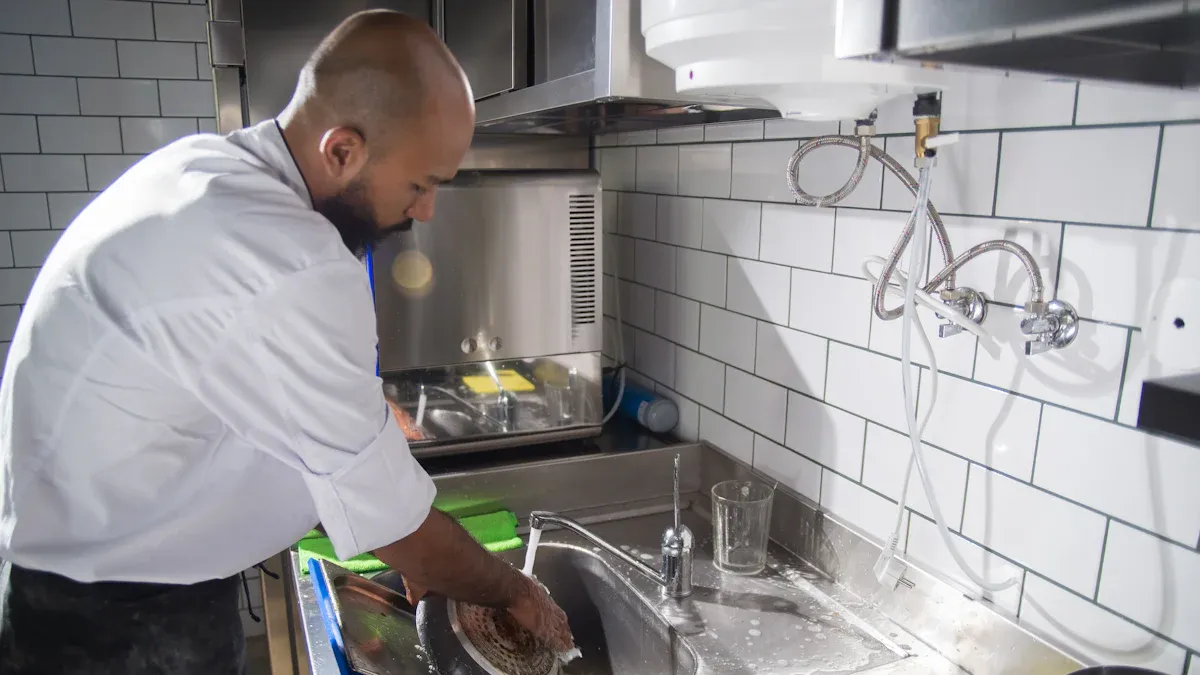
Keeping your kitchen clean is just as important as cooking great food. You need the right commercial dishwashing and cleaning equipment to meet health codes and keep your team safe. Let’s look at what you need for a spotless kitchen.
Commercial Dishwashers
A commercial dishwasher saves you time and helps you meet strict sanitation rules. These machines wash large loads fast, which is perfect for busy kitchens. Many new restaurants choose models with smart features that use less water and energy. You also get better cleaning with less effort. Here’s a quick look at what drives the choice of commercial dishwashers:
| Market Driver/Challenge | Explanation |
|---|---|
| Technological Advancements | Smart automation boosts washing power and saves resources |
| Energy Efficiency | Energy-star models lower costs and help the environment |
| Hygiene Regulations | Advanced sanitization features keep you compliant |
| Market Growth | More restaurants mean higher demand for efficient dishwashing |
| Sustainability Trends | Energy-saving machines are now a top choice |
Tip: Automated dishwashers help you handle labor shortages and keep up with high dish volumes.
Three-Compartment Sinks
You need a three-compartment sink for proper cleaning, rinsing, and sanitizing. Health inspectors look for this setup in every commercial kitchen. Each sink has a job: one for washing, one for rinsing, and one for sanitation. This method keeps your dishes safe and your kitchen up to code.
Pre-Rinse Units
Pre-rinse units spray off food before you load dishes into the dishwasher. You save water and time with these handy sprayers. Many commercial models use less water but still remove tough food bits. This step helps your dishwasher work better and last longer.
Grease Traps
Grease traps stop fats and oils from clogging your pipes. You need them in every commercial kitchen. Clean grease traps often to avoid plumbing problems and keep your kitchen running smoothly. A well-maintained grease trap also helps you meet sanitation standards.
- Automation and technology make cleaning easier.
- High-capacity dishwashers and proper sinks keep your kitchen safe and efficient.
- Good cleaning equipment supports food safety and helps new restaurants build a solid reputation.
Smallwares and Cooking Equipment for a Restaurant
Pots and Pans
You need the right pots and pans to handle daily cooking tasks. Stainless steel cookware stands out in busy kitchens because it lasts a long time and you can put it in the dishwasher. Some chefs like cast iron for searing because it holds heat well. Non-stick pans work for eggs or pancakes, but they wear out fast in a commercial setting. When you pick pots and pans, think about how easy they are to clean and how well they fit your menu.
Knives and Cutting Boards
Sharp knives help you prep food quickly and safely. Choose a set with different blade types for chopping, slicing, and dicing. Cutting boards come in plastic, wood, or composite materials. Color-coded boards help you avoid cross-contamination. The North America Food Service Supply Market Report shows more restaurants want durable, high-quality cutting boards because they last longer and keep food safe.
Mixing Bowls and Measuring Tools
Mixing bowls and measuring tools keep your recipes accurate. Stainless steel bowls resist dents and are easy to clean. Measuring cups and spoons help you follow recipes and control portions. High-quality smallwares like these save you money because you do not have to replace them often.
Cooking Utensils (Ladles, Tongs, Spatulas, etc.)
You use utensils every day, so invest in sturdy ones. Good ladles, tongs, and spatulas make cooking easier and faster. If you buy cheap tools, you will replace them often, which slows down your kitchen. Look for utensils that feel comfortable in your hand and can handle high heat.
Tip: Regularly check your utensils for wear and tear. Replacing them on time keeps your kitchen safe and efficient.
Baking Sheets and Trays
Baking sheets and trays help you roast, bake, and prep food in bulk. Choose heavy-duty options that do not warp in high heat. These tools support energy-saving practices and help you cook more food at once, which boosts your kitchen’s efficiency. When you select cooking equipment for a restaurant, always match the features to your menu and cooking style.
Safety and Sanitation Essentials in Commercial Kitchen Equipment
When you set up your commercial kitchen, safety and sanitation should always come first. The right equipment keeps your team safe and your food clean. Let’s look at the essentials you need.
Fire Suppression Systems
Every commercial kitchen needs a fire suppression system. Fires can start fast when you cook with hot oil or open flames. A good system puts out fires before they spread. You should check your system often and train your staff to use it. This step protects your business and keeps everyone safe.
First Aid Kits
Accidents can happen in any commercial kitchen. You need a first aid kit that is easy to find and fully stocked. Keep bandages, burn cream, and gloves inside. Make sure your team knows where the kit is and how to use it. Quick action can stop small injuries from getting worse.
Handwashing Stations
Handwashing stations help you keep germs away. Place them near food prep areas and entrances. Stock each station with soap, warm water, and paper towels. When your staff washes their hands often, you lower the risk of spreading illness. Health inspectors look for these stations in every commercial kitchen.
Cleaning Supplies
You need strong cleaning supplies to keep your kitchen spotless. Use commercial-grade cleaners for counters, floors, and equipment. Make a cleaning schedule and stick to it. Clean tools and surfaces help you meet sanitation rules and keep your food safe.
Tip: A clean commercial kitchen builds trust with your customers and keeps your staff healthy.
Key Considerations Before Buying Commercial Restaurant Equipment
Assessing Kitchen Space
Start by looking at your kitchen space. Measure every area before you buy anything. You want restaurant kitchen equipment that fits your layout and leaves room for staff to move safely. Picking the right size helps you avoid crowding and keeps your kitchen equipment list focused on what you really need.
Matching Equipment to Menu Needs
Think about your menu. Your kitchen equipment list should match the food you plan to serve. If you offer pizza, you need a pizza oven. For a salad bar, you need prep tables and coolers. Matching restaurant kitchen equipment to your menu keeps your kitchen running smoothly.
Quality and Durability
Choose high-quality, durable restaurant kitchen equipment. It may cost more at first, but it saves money over time. Strong equipment breaks less and lasts longer. Many restaurant owners find that investing in commercial-grade tools lowers maintenance costs and keeps the kitchen equipment checklist simple.
Budget Planning
Set your budget early. List your must-have items and compare prices. Remember, rent and kitchen space costs can change your budget. Try to balance quality, function, and price. This helps you avoid overspending and keeps your restaurant on track.
Maintenance and Warranties
Check if your equipment comes with a warranty. Maintenance contracts help you avoid costly repairs. Reliable after-sales support can extend the life of your restaurant kitchen equipment and keep your kitchen running.
New vs. Used Equipment
New equipment gives you warranties and peace of mind. Used equipment costs less but may need repairs. Weigh the pros and cons before adding anything to your kitchen equipment list.
Choosing Reliable Suppliers
Pick suppliers with a good reputation. Reliable suppliers help you get parts and service fast. This keeps your restaurant kitchen equipment working and your kitchen running without delays.
| Aspect | Key Points |
|---|---|
| Maintenance Contracts | Look for after-sales support to avoid breakdowns. |
| Kitchen Space Utilization | Choose equipment that fits your space and keeps staff safe. |
| Equipment Quality | Invest in durable, commercial-grade tools for long-term savings. |
| Supplier Reliability | Use trusted suppliers for parts and service. |
| New vs Used Equipment | New offers reliability; used saves money but may need repairs. |
| Cost Efficiency | New equipment is reliable; used may cost more in repairs. |
| Budget Considerations | Balance quality, function, and price for the best value. |
Frequently Forgotten Items and Pro Tips for New Restaurants
Starting a restaurant means juggling a lot of details. Some small but important items often slip through the cracks. Let’s make sure you don’t miss these essentials!
Thermometers and Timers
You need thermometers to keep food safe. Use them to check meat, soups, and even fridge temps. Digital thermometers give you quick, accurate readings. Timers help you avoid overcooked or burnt food. Place timers near every cooking station.
Pro Tip: Keep extra batteries for digital thermometers. You don’t want to scramble during a busy shift!
Backup Small Appliances
Blenders, food processors, and mixers can break at the worst times. If you have a backup, you can keep cooking without missing a beat. Even a simple hand mixer can save the day when your main one fails.
- Store backups in a labeled cabinet.
- Test them once a month to make sure they work.
- Rotate their use to keep them in good shape.
Labeling Supplies
Labels help you track food freshness and avoid waste. Use waterproof markers and date stickers on every container. Color-coded labels make it easy to spot what needs to be used first.
Note: Health inspectors love clear, accurate labels. You’ll pass inspections with less stress!
A little planning with these often-forgotten items keeps your kitchen running smoothly and your team ready for anything.
Careful planning makes your restaurant kitchen equipment work for you. When you choose the right restaurant kitchen equipment, you set your restaurant up for success. Stay organized with a kitchen equipment checklist. Want more help? Download our checklist, ask for expert advice, or check out trusted restaurant kitchen equipment suppliers.
FAQ
What is the most important piece of equipment for a new restaurant?
You can’t go wrong with a reliable range and oven. These tools help you cook almost everything on your menu.
How often should you clean commercial kitchen equipment?
You should clean most equipment daily. For deep cleaning, follow the manufacturer’s instructions. Cleanliness keeps your kitchen safe and your food tasting great.
Can you buy used commercial kitchen equipment?
Yes, you can. Used equipment saves money, but always check for damage and ask about warranties before you buy.


